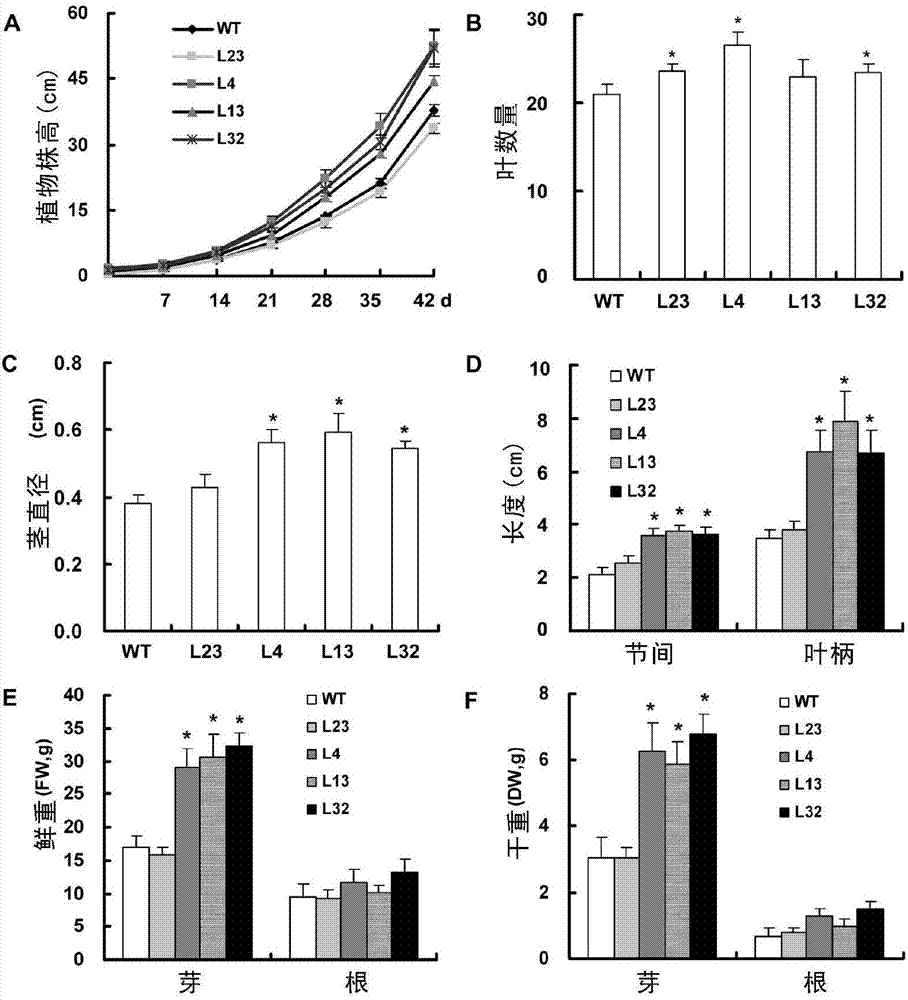Method for improving plant traits
A plant trait and plant technology, applied in the fields of genetic engineering and botany, can solve the problems of immature forest tree genetic transformation technology, short development time, and restrictions on the development of forest tree genetic engineering breeding
- Summary
- Abstract
- Description
- Claims
- Application Information
AI Technical Summary
Problems solved by technology
Method used
Image
Examples
Embodiment 1
[0139] Embodiment 1, the establishment of transgenic poplar
[0140] The OsCYP714D1 gene sequence derived from rice is as follows (SEQ ID NO: 1):
[0141] ATGGAGAGCTTCTTCGTCTTCTTCACGGCGGCGGCGTTGCCGGTGGTGGTGGCGGCGGCGGTGATCGCCGGGCTGTGCATTACGGCGGCGTG
[0142] GCTGGCGAGGCCGCGGCGCGTGGCGGAGGTGTTCCGGAGGCAGGGGATCGACGGCCCGCCGCCGTCGTCGTTCCTGGCGGGGAACCTCCCGG
[0143] AGATGAAGGCGAGGGTGGCCGCCGCGGCGTCGGCGGCGGCGCCAACGGCGGACGGGGAGGAGACCGCCTCCGCCGGCGGCGGCGGCGGTGGC
[0144] CGGGACTTCGAGAAGGACGGGTTCGACGACTACTGCACCAGGATCTTCCCTACTTCCACAAGTGGAGGAAAGCCTACGGCGAGACGTACCT
[0145] GTACTGGCTGCGGCGGCGGCCGGCGCTGTACGTGACGGACCCGGAGCTCATCGGCGAGATCGGGCGGTGCGTGTCGCTCGACATGGGCAAGC
[0146] CCAAGTACCTCCAGAAAGGCCAGGAGCCACTCTTCGGCGGCGGCGTCCTCAAGGCCAACGGCGCGTGCTGGGCGCGCCAGCGCAAGGTCATC
[0147] GCGCCGGAGTTCTACATGGCCCGTGTCAGGGCCATGGTCCAGCTCATGGTCGACGCCGCGCAGCCGCTGATCGCCTCCTGGGAATCCAGGAT
[0148] CGACGCCGCTGGAGGCGCGGCGGCGGCGGAGGTCGTCGTCGACGGCGACCTCCGGAGCTTCTCCTTCGATGTGATATCGCGGGCTTGCTTTG
[0149] GGAGTGATTACTCGA...
Embodiment 2
[0168] Embodiment 2, the phenotypic analysis of transgenic poplar
[0169] Transgenic poplars and wild-type poplars at the same growth period were transplanted into the soil, cultivated under the conditions of artificial climate chamber (temperature 22-25°C, light 12 hours / day, light intensity 6000 lux) and observed the phenotype. At the same time, a transgenic line (L23) that did not overexpress the OsCYP714D1 gene was used as a negative control.
[0170] Observations on poplars cultivated in soil for 2 months showed that L23, which had no difference in expression level from wild type (WT), was also similar in plant height to wild type, while the expression level of OsCYP714D1 was significantly higher than that of the wild type transgenic The plant height of the strain was significantly higher than that of the wild type (WT) ( figure 2 A), the stem diameter, leaf area and petiole length are also larger than the wild type ( figure 2 C, D), but there was no significant diff...
Embodiment 3
[0178] Embodiment 3, the analysis of endogenous gene expression
[0179] Using the HPLC method, the inventors measured the contents of endogenous hormones GA and IAA in transgenic poplar and wild-type poplar. The results of the determination and analysis of GA components and IAA content in leaves of wild type and transgenic lines showed that compared with wild type and L23, various GA components and IAA content in OsCYP714D1 gene overexpression lines L4, L13 and L32 The content of IAA was significantly increased ( Figure 6 ).
[0180] Further, the present inventors detected the effect of OsCYP714D1 gene on the expression levels of genes related to GA synthesis and signaling pathways in transgenic poplars and members of the PtCYP714 gene family in poplars. RT-PCR was used to analyze the expression of GA synthesis (GA20ox1,3,4) and decomposition (GA2ox1,2) related genes and GA receptor gene (PtGID1) in wild type and transgenic. The results showed that the RNA levels of these...
PUM
 Login to View More
Login to View More Abstract
Description
Claims
Application Information
 Login to View More
Login to View More - R&D
- Intellectual Property
- Life Sciences
- Materials
- Tech Scout
- Unparalleled Data Quality
- Higher Quality Content
- 60% Fewer Hallucinations
Browse by: Latest US Patents, China's latest patents, Technical Efficacy Thesaurus, Application Domain, Technology Topic, Popular Technical Reports.
© 2025 PatSnap. All rights reserved.Legal|Privacy policy|Modern Slavery Act Transparency Statement|Sitemap|About US| Contact US: help@patsnap.com



